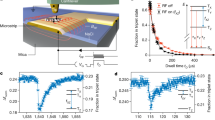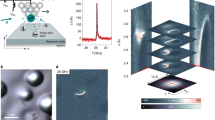Abstract
The ordering of neighbouring atomic magnetic moments (spins) leads to important collective phenomena such as ferromagnetism and antiferromagnetism. A full understanding of magnetism on the nanometre scale therefore calls for information on the arrangement of spins in real space and with atomic resolution. Spin-polarized scanning tunnelling microscopy accomplishes this1 but can probe only conducting materials. Force microscopy can be used on any sample independent of its conductivity. In particular, magnetic force microscopy2 is well suited to exploring ferromagnetic domain structures. However, atomic resolution cannot be achieved because data acquisition involves the sensing of long-range magnetostatic forces between tip and sample. Magnetic exchange force microscopy has been proposed3 for overcoming this limitation: by using an atomic force microscope4 with a magnetic tip, it should be possible to detect the short-range magnetic exchange force between tip and sample spins. Here we show for a prototypical antiferromagnetic insulator, the (001) surface of nickel oxide, that magnetic exchange force microscopy can indeed reveal the arrangement of both surface atoms and their spins simultaneously. In contrast with previous attempts to implement this method5,6,7,8, we use an external magnetic field to align the magnetic polarization at the tip apex so as to optimize the interaction between tip and sample spins. This allows us to observe the direct magnetic exchange coupling between the spins of the tip atom and sample atom that are closest to each other, and thereby demonstrate the potential of magnetic exchange force microscopy for investigations of inter-spin interactions at the atomic level.
This is a preview of subscription content, access via your institution
Access options
Subscribe to this journal
Receive 51 print issues and online access
$199.00 per year
only $3.90 per issue
Buy this article
- Purchase on Springer Link
- Instant access to full article PDF
Prices may be subject to local taxes which are calculated during checkout



Similar content being viewed by others
References
Heinze, S. et al. Real-space imaging of two-dimensional antiferromagnetism on the atomic scale. Science 288, 1805–1808 (2000)
Martin, Y. & Wickramasinghe, H. K. Magnetic imaging by ‘force microscopy’ with 1000 Å resolution. Appl. Phys. Lett. 50, 1455–1457 (1987)
Wiesendanger, R. et al. Vacuum tunneling of spin-polarized electrons detected by scanning tunnelling microscopy. J. Vac. Sci. Technol. B 9, 519–524 (1990)
Binnig, G., Quate, C. F. & Gerber, C. Atomic force microscope. Phys. Rev. Lett. 56, 930–933 (1986)
Hölscher, H., Langkat, S. M., Schwarz, A. & Wiesendanger, R. Measurement of three-dimensional force fields with atomic resolution using dynamic force spectroscopy. Appl. Phys. Lett. 81, 4428–4430 (2002)
Langkat, S., Hölscher, H., Schwarz, A. & Wiesendanger, R. Determination of site-specific forces between an iron coated tip and the NiO(001) surface by force field spectroscopy. Surf. Sci. 527, 12–20 (2003)
Hoffmann, R. et al. Atomic resolution imaging and frequency versus distance measurements on NiO(001) using low-temperature scanning force microscopy. Phys. Rev. B 67, 085402 (2003)
Hosoi, H., Sueoka, K. & Mukasa, K. Investigations on the topographical asymmetry of non-contact atomic force microscopy images of NiO(001) surface observed with a ferromagnetic tip. Nanotechnology 15, 506–509 (2004)
Albrecht, T. R., Grütter, P., Horne, D. & Rugar, D. Frequency modulation detection using high-Q cantilevers for enhanced force microscope sensitivity. J. Appl. Phys. 69, 669–673 (1991)
Giessibl, F. J. Atomic resolution of the silicon (111)-(7 × 7) surface by atomic force microscopy. Science 267, 68–71 (1995)
Morita, S., Wiesendanger, R. & Meyer, E. Noncontact Atomic Force Microscopy (Springer, Berlin, 2002)
Okazawa, T., Yagi, Y. & Kido, Y. Rumpled surface structure and lattice dynamics of NiO(001). Phys. Rev. B 67, 195406 (2003)
Anderson, P. W. Antiferromagnetism. Theory of superexchange interaction. Phys. Rev. 79, 350–356 (1950)
Hillebrecht, F. U. et al. Magnetic moments at the surface of antiferromagnetic NiO(100). Phys. Rev. Lett. 86, 3419–3422 (2001)
Liebmann, M., Schwarz, A., Langkat, S. M. & Wiesendanger, R. A low-temperature ultrahigh vacuum scanning force microscope with a split-coil magnet. Rev. Sci. Instrum. 73, 3508–3514 (2002)
Kubetzka, A. et al. Revealing antiferromagnetic order of the Fe monolayer on W(001): spin-polarized scanning tunneling microscopy and first-principles calculations. Phys. Rev. Lett. 94, 087204 (2005)
Castell, M. R., Dudarev, S. L., Briggs, G. A. D. & Sutton, A. P. Unexpected differences in the surface electronic structure of NiO and CoO observed by STM and explained by first-principles theory. Phys. Rev. B 59, 7342–7345 (1999)
Regan, T. J. et al. Chemical effects at metal/oxide interfaces studied by x-ray-absorption spectroscopy. Phys. Rev. B 64, 214422 (2001)
Foster, A. S. & Shluger, A. L. Spin contrast in non-contact SFM on oxide surfaces: Theoretical modelling of NiO(001) surface. Surf. Sci. 490, 211–219 (2001)
Momida, H. & Oguchi, T. First-principles study on exchange force image of NiO(001) surface using a ferromagnetic Fe probe. Surf. Sci. 590, 42–50 (2005)
Castell, M. R. et al. Atomic-resolution STM of a system with strongly correlated electrons: NiO(001) surface structure and defect sites. Phys. Rev. B 55, 7859–7863 (1997)
Nogues, J. & Schuller, I. K. Exchange bias. J. Magn. Magn. Mater. 192, 203–232 (1999)
Acknowledgements
This work was supported by a grant from the Sonderforschungsbereich Magnetismus vom Einzelatom zur Nanostruktur of the Deutsche Forschungsgemeinschaft.
Author information
Authors and Affiliations
Corresponding author
Ethics declarations
Competing interests
Reprints and permissions information is available at www.nature.com/reprints. The authors declare no competing financial interests.
Supplementary information
Supplementary Information
This file contains Supplementary Figures S1-S5 with Legends and Supplementary Discussion. The Supplementary Information contains eight sections. They describe the AFM set-up (section S1) and the methods employed to characterise the tip (section S2 and S3), which in turn allows to identify the two atomic species on the nickel oxide surface (section S4). The role of the magnetic polarisation at the tip apex and its controlled manipulation in a favourable direction is explained in section S5. More details regarding the exclusion of an oscillatory noise source and a tip artefact are given in section S6 and S7, respectively. Finally, section S8 refers to previous attempts to perform MExFM. (PDF 342 kb)
Rights and permissions
About this article
Cite this article
Kaiser, U., Schwarz, A. & Wiesendanger, R. Magnetic exchange force microscopy with atomic resolution. Nature 446, 522–525 (2007). https://doi.org/10.1038/nature05617
Received:
Accepted:
Issue Date:
DOI: https://doi.org/10.1038/nature05617
This article is cited by
-
Fundamental quantum limits of magnetic nearfield measurements
npj Quantum Information (2023)
-
Magnetic control over the fundamental structure of atomic wires
Nature Communications (2022)
-
Challenges in identifying chiral spin textures via the topological Hall effect
Communications Materials (2022)
-
Negative differential friction coefficients of two-dimensional commensurate contacts dominated by electronic phase transition
Nano Research (2022)
-
Scanning probe microscopy
Nature Reviews Methods Primers (2021)
Comments
By submitting a comment you agree to abide by our Terms and Community Guidelines. If you find something abusive or that does not comply with our terms or guidelines please flag it as inappropriate.



